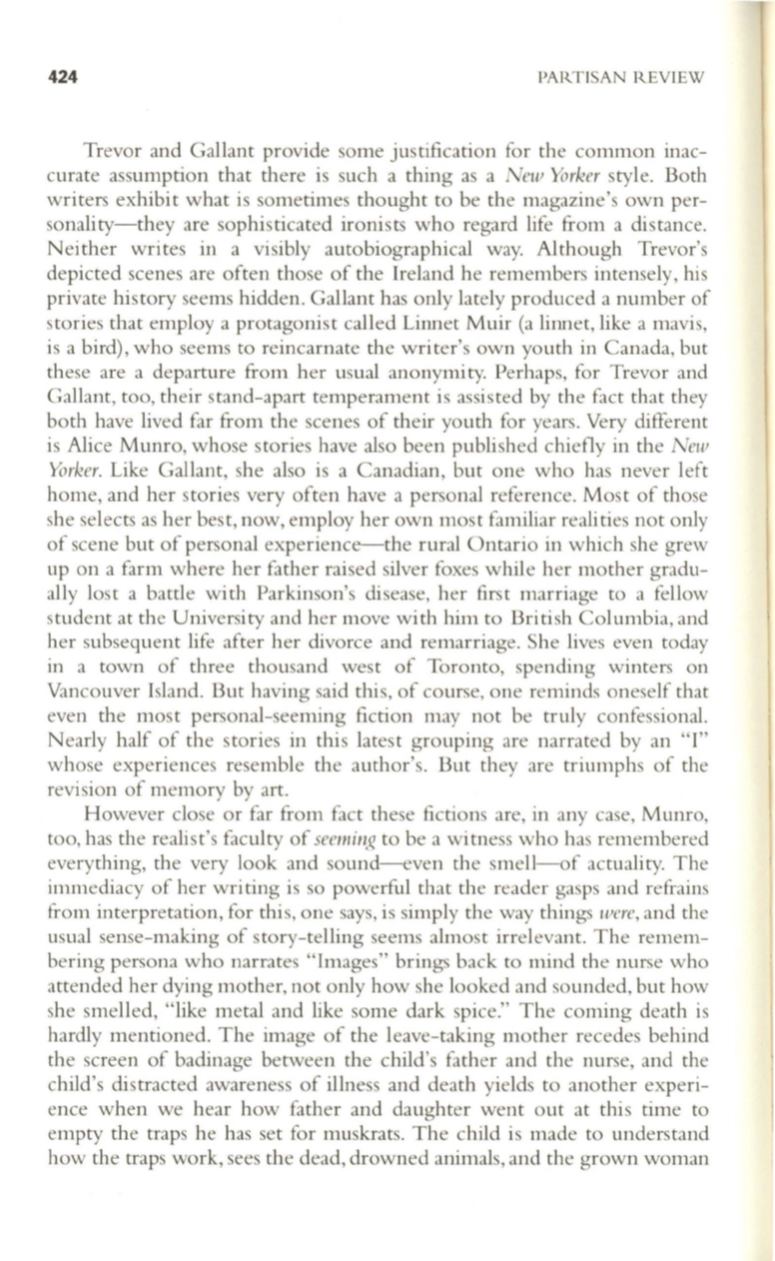
424
PARTISAN ftEVIEW
Trevor and Gallant provide some justification for the common inac–
curate assumption that there is such a thing as a
New Yorker
style. Both
writers exhibit what is sometimes thought to be the magazine's own per–
sonality-they are sophisticated ironists who regard life from a distance.
Neither writes in a visibly autobiographical way. Although Trevor's
depicted scenes are often those of the Ireland he remembers intensely, his
private history seems hidden. Gallant has only lately produced a number of
stories that employ a protagonist called Linnet Muir (a linnet, like a mavis,
is a bird), who seems to reincarnate the writer's own youth in Canada, but
these are a departure from her usual anonymity. Perhaps, for Trevor and
Gallant, too, their stand-apart temperament is assisted by the fact that they
both have lived far from the scenes of their youth for years. Very different
is Alice Munro, whose stories have also been published chiefly in the
New
Yorker.
Like Gallant, she also is a Canadian, but one who has never left
home, and her stories very often have a personal reference. Most of those
she selects as her best, now, employ her own most familiar realities not only
of scene but of personal experience-the rural Ontario in which she grew
up on a farm where her father raised silver foxes while her mother gradu–
ally lost a battle with Parkinson's disease, her first marriage to a fellow
student at the University and her move with him to British Columbia, and
her subsequent life after her divorce and remarriage. She lives even today
in a town of three thousand west of Toronto, spending winters on
Vancouver Island. But having said this, of course, one reminds oneself that
even the most personal-seeming fiction may not be truly confessional.
Nearly half of the stories in this latest grouping are narrated by an "I"
whose experiences resemble the author's. But they are triumphs of the
revision of memory by art.
However close or far from fact these fictions are, in any case, Munro,
too, has the realist's faculty of
seeming
to be a witness who has remembered
everything, the very look and sound-even the smell-of actuality. The
immediacy of her writing is so powerful that the reader gasps and refrains
from interpretation, for this, one says, is simply the way things
were,
and the
usual sense-making of story-telling seems almost irrelevant. The remem–
bering persona who narrates "Images" brings back to mind the nurse who
attended her dying mother, not only how she looked and sounded, but how
she smelled, "like metal and like some dark spice." The coming death is
hardly mentioned. The image of the leave-taking mother recedes behind
the screen of badinage between the child's father and the nurse, and the
child's distracted awareness of illness and death yields to another experi–
ence when we hear how father and daughter went out at this time to
empty the traps he has set for muskrats. The child is made to understand
how the traps work, sees the dead, drowned animals, and the grown woman


